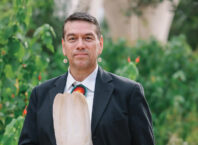
By Chandra Colvin/MPR News
For many, summertime activities such as boating and swimming are first to mind when visiting Big Sandy Lake near McGregor in northern Minnesota. However, to several generations of Ojibwe people, the shoreline of the lake is described as a “graveyard.”
Every year on the last Wednesday of July, Native communities and allies from Minnesota, Wisconsin and Michigan gather for the annual Sandy Lake Memorial, a ceremony also called Mikwendaagoziwag.
In the Ojibwe language, Mikwendaagoziwag means “they are remembered.” The day honors what is now known as the Sandy Lake Tragedy, an event that led to the deaths of more than 400 Ojibwe tribal members in the winter of 1850-51.
The morning begins with a commemorative canoe paddle starting at Big Sandy Lake’s eastern side in the morning. Participants set their canoes alongside the lakeshore before standing together in a circle for a morning prayer led by Red Cliff Band of Lake Superior Chippewa band member Misty Shogaabawiikwe Nordin.
“Looking around and seeing everyone gathered here for the same purpose, right, to acknowledge what had happened and to come together for some healing,” said Nordin.
Canoeists then offer tobacco to the lake’s waters before embarking on a four-mile paddle to the northwestern corner of Big Sandy Lake, where a Mikwendaagoziwag Memorial site sits on top of a small hill overlooking the waters.
“There are many tragic things that have happened to Indigenous people and their encounters with European nations, but we pride ourselves in surviving,” said Great Lakes Indian Fish and Wildlife Commission executive administrator Jason Schlender, a member of the Lac Courte Oreilles Band of Lake Superior Chippewa Indians in Wisconsin.
The organization has been holding a remembrance ceremony for over two decades, which has grown from an attendance of about 15 to more than 300.

‘It was a scheme that was concocted’
In the fall and early winter of 1850, Ojibwe tribes living along the shores of Lake Superior in Wisconsin and Upper Michigan were ordered to gather at Big Sandy Lake to collect annuity payments. Up until then, tribal members had been going to La Pointe on Madeline Island in Wisconsin for payments, per government treaties of 1837 and 1842. In exchange for the rights of a total 23-million-acres, tribes were to receive payment as well as to retain the right to hunt, fish and gather on unceded lands.
According to some historians and tribal leaders, then-territorial governor of Minnesota Alexander Ramsey and Indian sub-agent John Watrous “concocted” a plan that would move the distribution site after an initial failed attempt at removal of Wisconsin and Michigan tribes.
A removal would open Ojibwe territory to settlers alongside access to natural resources — a violation of treaties. Band members and allies alike opposed the removal effort and refused to leave their lands.
“The entire mission of the U.S. government, and what they what they were trying to do to us and remove us and to kill us off, just to get our land,” Nordin said. “We have a right to exist. And we had a right to exist even then.”
Ramsey and Watrous then informed tribes the payment site had been changed from La Pointe to Big Sandy Lake, an approximate 285-mile canoe ride west. Moving the site into Minnesota would also allegedly bring economic benefit to the state, which at the time was petitioning to join the union.
“5,000 Ojibwe people showed up. When they arrived, there was nothing there,” said Schlender.
Jean Skinaway-Lawrence is the chairwoman of the Sandy Lake Band of Mississippi Chippewa, located around Big Sandy Lake and near Savanna Portage State Park in McGregor. She says Minnesota tribes aided those who came to Big Sandy Lake, but resources were scarce.
“[We] had to help our brethren from Wisconsin when they came. So, we were part of that tragedy,” she said.
Schlender says other than sparse amounts of rotted food and minimal supplies, annuity payments did not arrive until December. Approximately 150 people died at Big Sandy Lake, including women, children and elders.
By the time snow was on the ground and waterways had frozen over, many families began to return to Wisconsin and Michigan by foot, where another 250 died along the way.
In total, some 400 people died due to starvation, illness and harsh weather conditions. A Mikwendaagoziwag Memorial site now sits at the Sandy Lake Recreation Area, operated by the U.S. Army Corps of Engineers. The memorial is located on Big Sandy Lake’s northwestern side, facing the lake with a backdrop of pine trees.
A large stone includes the names of the affected present-day Ojibwe tribes. A commemoration stone for each person who died is embedded into the memorial, all hand-picked by early founders. The memorial reads, “We remember the 400 Anishinaabeg who died in the winter of 1850-51.”

‘Our ancestors still deserve for us to remember them’
An afternoon feast and gathering is held near the site as canoeists arrive within 45 minutes to an hour of their morning departure. Before the paddle started, leaders emphasized that it was not a race, but some took it as a challenge regardless with lighthearted fun.
As people began to appear in their canoes off in the distance, those waiting for them clapped for their arrival.
Tom Maulson is a member of the Lac du Flambeau Band of Lake Superior Chippewa Indians in Wisconsin. He is a former chairman of the Great Lakes Indian Fish and Wildlife Commission and was there when the organization held its first canoe paddle and ceremony.
“It was unique. It was sad. It was happy. I remember paddling across the lake where we show our recognition for the ones that passed,” Maulson said while recalling that first year. “We know that we’re by their sides here. We want to make sure that they’re not forgotten.”
For many attending, the memorial ceremony is a testament to the survival and perseverance of their ancestors. For others, it proves to be a reminder to lessons of past mistakes.
Tribal president of Lac du Flambeau Band of Lake Superior Chippewa Indians John Johnson Sr. participated in the canoe paddle this year. He emphasized the need to remember past broken treaties, and to ensure treaty rights are respected going forward.
“It’s good for reminders, so our kids don’t have to repeat the past. We’re trying to teach them to be better people, better educated when time comes for the future,” Johnson said.
The afternoon began with song and prayer, as well as a recognition of those involved in the founding of the memorial. Tribal leaders and members took turns speaking in front of everyone, acknowledging the events of what happened at Big Sandy Lake. Some teared up as they spoke, while others shared stories of previous Mikwendaagoziwag ceremonies with lightheartedness.

While the events of 1850 hold somber, the gathering itself is filled with feelings of hope and self-reflection.
“[We] just have to keep feeding those spirits, feeding our spirits, their spirits and just keep honoring those yet to come. And that’s my belief, and we most certainly do that here at Sandy Lake,” Skinaway-Lawrence said.
In the following years after the Sandy Lake Tragedy, Ojibwe bands and allies continued to oppose attempts at removal from Wisconsin and Upper Michigan. Schlender says continuing to tell the story is important, so people never forget what happened.
“People will sometimes say, you know, have we mourned enough? Have we grieved enough for them so that we move on?” he said. “I would say no, because we still have social issues and health issues and things that still impact us that are directly related to those things.”
Schlender says that while many Ojibwe people are flourishing now, trauma can last years, even centuries. However, attending ceremonies such as the Sandy Lake Memorial can be a path in the right direction to healing for many.






